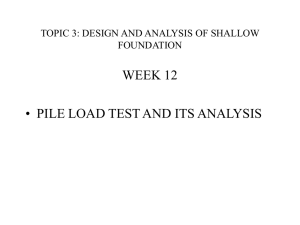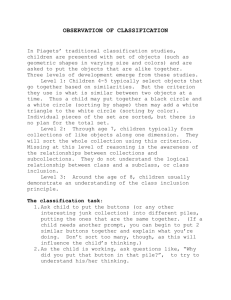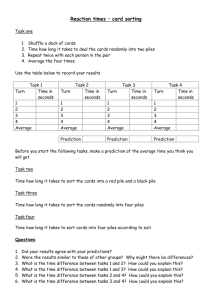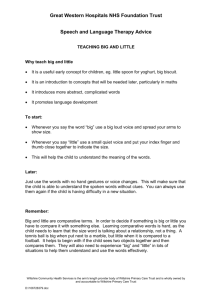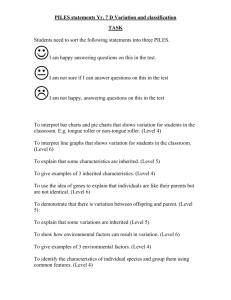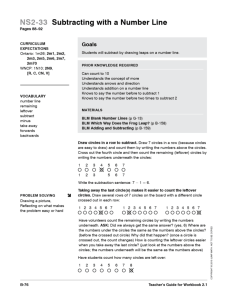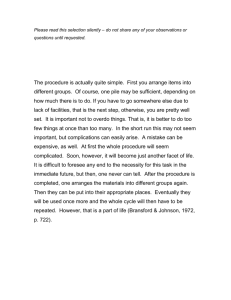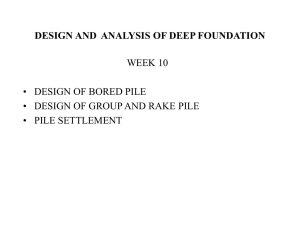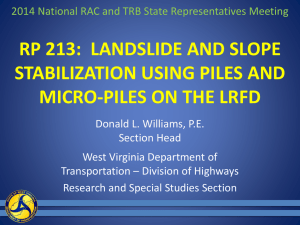PILE FOUNDATIONS
advertisement
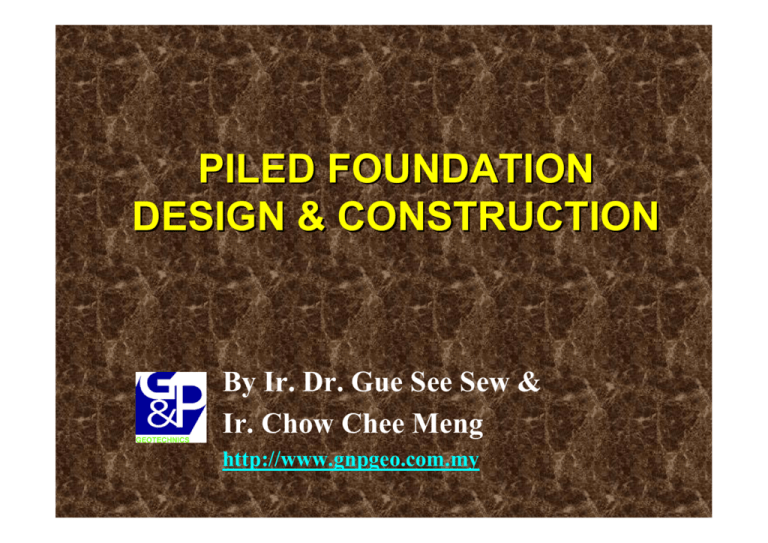
PILED FOUNDATION
DESIGN & CONSTRUCTION
By Ir. Dr. Gue See Sew &
Ir. Chow Chee Meng
http://www.gnpgeo.com.my
Contents
z Overview
z Preliminary
Study
z Site
Visit & SI Planning
z Pile
Design
z Pile
Installation Methods
z Types
of Piles
Contents (Cont’d)
z Piling
z Pile
Supervision
Damage
z Piling
Problems
z Typical
z Myths
z Case
Design and Construction Issues
in Piling
Histories
z Conclusions
Overview
What is a Pile Foundation
It is a foundation system that
transfers loads to a deeper
and competent soil layer.
When To Use Pile Foundations
• Inadequate Bearing Capacity of Shallow
Foundations
• To Prevent Uplift Forces
• To Reduce Excessive Settlement
PILE CLASSIFICATION
z Friction
Pile
– Load Bearing Resistance derived mainly
from skin friction
z End
Bearing Pile
– Load Bearing Resistance derived mainly
from base
Friction Pile
Overburden Soil Layer
End Bearing Pile
Overburden Soil
Rock / Hard Layer
Preliminary Study
Preliminary Study
z Type
& Requirements of Superstructure
z Proposed
Platform Level (ie CUT or FILL)
z Geology
of Area
z Previous
Data or Case Histories
z Subsurface
z Selection
Investigation Planning
of Types & Size of Piles
Previous Data & Case
Histories
Existing
Development
A
Proposed
Development
Only Need Minimal
Number of Boreholes
Bedrock
Profile
Existing
Development
B
Challenge The Norm Thru
Innovation To Excel
SELECTION OF PILES
Factors Influencing Pile Selection
– Types of Piles Available in Market (see Fig. 1)
– Installation Method
– Contractual Requirements
– Ground Conditions (eg Limestone, etc)
– Site Conditions & Constraints (eg Accessibility)
– Type and Magnitude of Loading
– Development Program & Cost
– etc
TYPE OF PILES
DISPLACEMENT PILES
TOTALLY PREFORMED PILES
(A ready-made pile is driven or jacked
into the ground)
Hollow
Small displacement
Steel Pipe
Precast R.C.
piles
Bored piles
Micro piles
DRIVEN CAST IN-PLACE PILES
(a tube is driven into ground to
form void)
Solid
Concrete Spun Piles
Concrete
NON-DISPLACEMENT PILES
Steel H-piles
(small displacement)
Concrete Tube
Closed ended
tube concreted
with tube left in
position
Bakau piles
Treated timber pile
Precast prestressed
piles
FIG 1: CLASSIFICATION OF PILES
Steel Tube
Closed ended tube
Open ended tube
extracted while
concreting (Franki)
Restricted use due to
environmental
considerations
PREFORMED PILES
<100 KN
300-600
a
?
SCALE OF LOAD
(STRUCTURAL)
100-300
BEARING TYPE
?
?
?
a
a
a
a
a
?
a
a
?
?
AUGERED PILES
MICROPILES
BORED PILES
STEEL H PILES
SPUN PILES
PSC PILES
a
a
x
?
a
a
x
a
a
a
a
a
a
600-1100
x
a
a
a
a
a
a
?
a
a
a
?
1100-2000
x
?
a
a
a
a
a
?
a
a
?
2000-5000
x
x
a
a
a
a
a
?
a
a
?
5000-10000
x
x
a
a
a
a
x
a
x
x
?
?
?
a
?
a
?
a
?
a
<5m
a
?
x
a
?
x
>10000
a
?
x
a
a
?
5-10m
a
?
a
?
a
a
a
a
a
?
a
a
a
10-20m
a
a
a
a
a
a
a
a
a
20-30m
x
x
a
a
a
a
a
a
a
a
30-60m
x
x
a
a
a
a
a
a
MAINLY FRICTION
a
a
a
a
a
a
?
a
?
a
a
a
?
a
PARTLY FRICTION + PARTLY END BEARING
a
?
a
?
a
?
a
?
a
a
a
a
a
a
a
WEATHERED ROCK / SOFT ROCK
x
x
a
a
a
?
x
a
?
a
x
a
?
a
ROCK (RQD > 70%)
a
?
a
?
a
?
?
LIMESTON FORMATION
a
?
a
a
?
a
a
?
DENSE / VERY DENSE SAND
x
?
a
a
a
a
a
a
a
a
SOFT SPT < 4
a
a
a
a
a
a
a
a
a
a
?
a
M. STIFF SPT = 4 - 15
a
a
a
a
a
a
a
a
a
a
V. STIFF SPT = 15 - 32
a
?
a
a
a
a
a
a
a
a
a
HARD SPT > 32
x
a
?
a
a
a
a
a
a
a
a
a
LOOSE SPT < 10
a
a
a
a
a
a
a
a
a
a
M. DENSE SPT = 10 - 30
a
?
a
a
a
a
a
a
a
a
a
DENSE SPT = 30 - 50
x
a
?
a
a
a
a
a
a
a
V. DENSE SPT > 50
x
x
a
a
a
a
a
a
?
a
a
a
?
?
MAINLY END -BEARING
(D=Anticipated depth of bearing)
TYPE OF INTERMEDIATE LAYER
a
a
?
COMPRESSIVE LOAD PER COLUMN
TYPE OF
BEARING
LAYER
GEOTECHNICAL
a
RC PILES
BAKAU PILES
DESIGN
CONSIDERATIONS
COHESIVE SOIL
COHESIVELESS SOIL
SOIL WITH SOME BOULDERS /
COBBLES (S=SIZE)
S < 100 mm
x
?
100-1000mm
x
x
a
?
a
?
a
?
1000-3000mm
x
x
?
?
>3000mm
x
x
?
a
x
a
GROUND ABOVE PILE CAP
WATER BELOW PILE CAP
NOISE + VIBRATION; COUNTER MEASURES
ENVIRONME REQUIRED
NT
PREVENTION OF EFFECTS ON ADJOINING
STRUCTURES
UNIT COST
TIMPER PILES
TYPE OF PILE
JACKED PILES
STEEL PIPE PILES
LEGEND :
(SUPPLY & INSTALL) RM/TON/M
a
a
?
a
?
a
?
?
?
?
a
a
a
a
a
a
a
a
?
?
?
?
?
?
0.5-2.5
0.3-2.0
INDICATES THAT THE PILE TYPE IS
SUITABLE
x
INDICATES THAT THE PILE TYPE IS
NOT SUITABLE
?
INDICATES THAT THE USE OF PILE
TYPE IS DOUBTFUL OR NOT COST
EFFECTIVE UNLESS ADDITIONAL
MEASURES TAKEN
x
a
a
a
a
x
?
a
?
a
x
?
?
?
a
x
a
a
a
a
a
a
a
a
a
a
a
a
a
?
?
?
a
a
a
a
?
?
?
a
?
a
a
1-2
0.5-2
1.5-3
1-2.5
1.0-3.5
a
?
8
FIG 2 : PILE SELECTION CHART
Site Visit and SI Planning
Site Visit
Things To Look For …
z Accessibility & Constraints of Site
z Adjacent
Structures/Slopes, Rivers,
Boulders, etc
z Adjacent
Activities (eg excavation)
z Confirm
Topography & Site Conditions
z Any
Other Observations that may affect
Design and Construction of Foundation
Subsurface Investigation (SI)
Planning
z
Provide Sufficient Boreholes to get Subsoil Profile
z
Collect Rock Samples for Strength Tests (eg UCT)
z
In-Situ Tests to get consistency of ground (eg SPT)
z
Classification Tests to Determine Soil Type
Profile
z
Soil Strength Tests (eg CIU)
z
Chemical Tests (eg Chlorine, Sulphate, etc)
Typical Cross-Section at Hill Site
Ground Level
Hard Material Level
Very Hard Material Level
Bedrock Level
Groundwater Level
CROSS SECTION
BH
BH
BH
Seepage
Water Table
EXISTING
GROUND
LEVEL
C’1, ø’1
ø’ 2
,
’
2
er C
T
y
W
a
d
he
yL
c
e
r
y
e
P
Cla
C’3, ø’3
Placing Boreholes in Limestone
Areas
z
Stage 1 : Preliminary S.I.
- Carry out geophysical survey (for large areas)
z
Stage 2: Detailed S.I.
- Boreholes at Critical Areas Interpreted from
Stage 1
z
Stage 3: During Construction
- Rock Probing at Selected Columns to
supplement Stage 2
Pile Design
PILE DESIGN
Allowable Pile Capacity is the minimum of :
1) Allowable Structural Capacity
2) Allowable Geotechnical Capacity
a. Negative Skin Friction
b. Settlement Control
PILE DESIGN
Structural consideration
•
Not overstressed during handling, installation & in
service for pile body, pile head, joint & shoe.
•
Dimension & alignment tolerances (common
defects?)
•
Compute the allowable load in soft soil (<10kPa)
over hard stratum (buckling load)
•
Durability assessment
Pile Capacity Design
Structural Capacity
Qall = Allowable pile
z
Concrete Pile
Qall = 0.25 x fcu x Ac
capacity
fcu = characteristic strength
of concrete
fs = yield strength of steel
z
Steel Pile
Qall = 0.3 x fy x As
Ac = cross sectional area of
concrete
As = cross sectional area of
steel
z
Prestressed Concrete Pile
Qall = 0.25 (fcu – Prestress after loss) x Ac
Pile Capacity Design
Geotechnical Capacity
Collection of SI Data
Depth Vs SPT-N Blow Count
0
50
100
150
200
250
300
350
400
0
0
2
Depth (m)
4
2
6
8
Upper Bound
4
10
12
6
14
16
8
18
20
Lower
Bound
22
24
Design Line
(Moderately
Conservative)
10
26
12
0
50
100
150
200
250
300
350
400
SPT Blow Count per 300mm Penetration
Pile Capacity Design
Geotechnical Capacity
Collection of SI Data
Depth Vs SPT-N Blow Count
Depth Vs SPT-N Blow Count
0
50
100
150
200
250
300
350
0
400
0
100
150
200
250
300
350
400
0
0
0
2
2
4
4
2
2
6
8
Upper Bound
4
10
12
6
14
Depth (m)
6
Depth (m)
50
8
4
10
12
6
14
16
16
18
Lower
Bound
20
8
Design Line
8
18
Upper Bound
20
10
22
22
Lower
Bound
10
Design Line
24
24
26
12
0
50
100
150
200
250
300
350
400
SPT Blow Count per 300mm Penetration
26
12
0
50
100
150
200
250
300
350
400
SPT Blow Count per 300mm Penetration
Moderately Conservative
Design Parameters
z Eurocode
7 definition:
– Characteristic value of a geotechnical
parameter shall be selected as a cautious
estimate of the value affecting the occurrence
of the limit state
– In other words, moderately conservative
Moderately Conservative
Design Parameters
z If
at least 10 test results are available:
– A value of 0.5D below the mean of the test
results provides a useful indication of the
characteristic value
1. Contribution to Discussion Session 2.3, XIV ICSMFE, Hamburg, Balkema, Schneider H R (1997) – Definition and
determination of characteristic soil properties. Discussion to ISSMFE Conference, Hamburg.
2. Extracted from Prof. Brian Simpson’s Course Note (2-day Course on Eurocode 7 Geotechnical Design to EC7, 13-14
November 2007, PJ, Malaysia).
Extracted from Prof. Brian Simpson’s Course Note (2-day Course on Eurocode 7 Geotechnical Design to EC7, 13-14
November 2007, PJ, Malaysia).
Pile Capacity Design
Geotechnical Capacity
• Piles installed in a group may fail:
• Individually
• As a block
Pile Capacity Design
Geotechnical Capacity
• Piles fail individually
• When installed at large spacing
Pile Capacity Design
Geotechnical Capacity
• Piles fail as a block
• When installed at close spacing
Pile Capacity Design
Single Pile Capacity
Pile Capacity Design
Factor of Safety (FOS)
Factor of Safety (FOS) is required
for
z Natural variations in soil strength &
compressibility
Pile Capacity Design
Factor of Safety (FOS)
z Different degree of
mobilisation for shaft
& for tip
Load
Factor of Safety is
(FOS) required for
qsmob
qbmob
≈ 5mm
Settlement
Pile Capacity Design
Factor of Safety (FOS)
Partial factors of safety for shaft & base
capacities respectively
z For shaft, use 1.5 (typical)
z For base, use 3.0 (typical)
z Qall = ΣQsu + Qbu
1.5
3.0
Pile Capacity Design
Factor of Safety (FOS)
Global factor of safety for total ultimate
capacity
z Use 2.0 (typical)
z Qall = ΣQsu + Qbu
2.0
Pile Capacity Design
Factor of Safety (FOS)
z Calculate using BOTH approaches
(Partial & Global)
z Choose the lower of the Qall values
Pile Capacity Design
Single Pile Capacity
Qu = Qs + Qb
Qu = ultimate bearing capacity
Qs = skin friction
Qb = end bearing
Overburden Soil Layer
Pile Capacity Design
Single Pile Capacity : In Cohesive Soil
Qsu
Qbu
Qu = α.sus.As + sub.Nc.Ab
Qu = Ultimate bearing capacity of the pile
a = adhesion factor (see next slide)
sus = average undrained shear strength for shaft
As = surface area of shaft
sub = undrained shear strength at pile base
Nc = bearing capacity factor (taken as 9.0)
Ab = cross sectional area of pile base
Pile Capacity Design
Single Pile Capacity: In Cohesive Soil
Adhesion factor (α) – Shear strength (Su)
(McClelland, 1974)
1.0
Preferred
Design Line
0.8
0.6
Cα/Su
0.4
Adhesion
Factor
0.2
0
25
50
75
100
Su (kN/m2)
125
150
175
Meyerhof
Fukuoka
SPT N
fsu=2.5N
(kPa)
su =
(0.1+0.15N)*50
(kPa)
α
fsu=α.su
(kPa)
0
0
5
1
5
1
2.5
12.5
1
12.5
5
12.5
42.5
0.7
29.75
10
25
80
0.52
41.6
15
37.5
117.5
0.4
47
20
50
155
0.33
51.15
30
75
230
0.3
69
40
100
305
0.3
91.5
Pile Capacity Design
Single Pile Capacity: In Cohesive Soil
Correlation Between SPT N and fsu
fsu vs SPT N
110
100
90
80
fsu
(kPa)
70
60
50
40
30
20
10
0
0
5
10
15
20
25
30
SPT N
Meyerhof
Fukuoka
35
40
45
Pile Capacity Design
Single Pile Capacity: In Cohesive Soil
z Values of undrained shear strength, su can be
obtained from the following:
9 Unconfined compressive test
9 Field vane shear test
9 Deduce based on Fukuoka’s Plot (minimum su )
Deduce from SPT-N values based on Meyerhof
NOTE: Use only direct field data for shaft friction prediction
instead of Meyerhof
Pile Capacity Design
Single Pile Capacity: In Cohesive Soil
Modified Meyerhof (1976):
Ult. Shaft friction = Qsu ≅ 2.5N (kPa)
Ult. Toe capacity = Qbu ≅ 250N (kPa)
or 9 su (kPa)
(Beware of base cleaning for bored piles –
ignore base capacity if doubtful)
Pile Capacity Design
Single Pile Capacity: In Cohesionless Soil
Modified Meyerhof (1976):
z Ult. Shaft Friction = Qsu ≅ 2.0N (kPa)
z Ult. Toe Capacity= Qbu ≅ 250N – 400N
(kPa)
Pile Capacity Design
Load (kN)
00
100
100
200
200
300
300
400
400
500
500
00
00
44
44
Depth (m)
ΣQsu
Qbu
ΣQsu + Qbu
88
12
12
88
ΣQsu + Qbu
2.0
ΣQsu + Qbu
1.5
3.0
12
12
16
16
16
16
20
20
20
20
00
200
200
400
400
600
600
Pile Capacity Design
Single Pile Capacity: For Bored Piles
Semi-empirical Method (SPT-N)
Shaft : fsu = Ksu × SPT-N
Tip : fbu = Kbu × SPT-N
From Malaysian experience:
Ksu = 2.0
Kbu = 7.0 to 60 (depending on workmanship)
Pile Capacity Design
Single Pile Capacity: For Bored Piles
z Base
cleaning of bored piles
– Difficult and no practical means of verification
during construction avaliable
z Base
resistance require large movement to
mobilise
z Base
contribution in bored pile design
ignored unless proper base cleaning can be
assured and verified (or base grouting, etc.)
Rock Socket Design
Rock Socket Design Factors :
• Socket Roughness (Shearing Dilation)
• Intact Rock UCS, quc
• Confining Stiffness (Rock mass fractures
& Pile Diameter)
• Socket Geometry Ratio
Socket Resistance, fs = α × β × quc
α - Factor (after Tomlinson, 1995)
β - Factor (after Tomlinson, 1995)
Point Load Test
(UCS of Intact Rock)
Load Transfer Profile of Rock Socket
(after Pells & Tuner, 1979)
Summary of Rock Socket Friction Design
Values (updated from Tan & Chow, 2003)
Rock Formation
Working Rock Socket Friction*
Source
Limestone
300kPa for RQD < 30%
400kPa for RQD = 30 %
500kPa for RQD =40 %
600kPa for RQD =55 %
700kPa for RQD =70 %
800kPa for RQD > 85%
The above design values are subject to 0.05x
minimum of {quc, fcu} whichever is smaller.
Authors
Sandstone
0.10×quc
Thorne (1977)
Shale
0.05×quc
Thorne (1977)
Granite
1000 – 1500kPa for quc > 30N/mm2
Where:
RQD =
quc
=
fcu
=
Tan & Chow (2003)
Rock Quality Designation
Unconfined Compressive Strength of rock
Concrete grade
End Bearing Design in Rock
Only designed when
• Dry Hole
• Base Cleaning & Inspection are possible
Pile Capacity Design
Block Capacity
Pile Capacity Design
Block Capacity:In Cohesive Soil
Qu = 2D(B+L) s + 1.3(sb.Nc.B.L)
Where
Qu= ultimate bearing capacity of pile group
D = depth of pile below pile cap level
B = width of pile group
L = length of pile group
s = average cohesion of clay around group
sb = cohesion of clay beneath group
Nc= bearing capacity factor = 9.0
(Refer to Text by Tomlinson, 1995)
Pile Capacity Design
Block Capacity: In Cohesionless Soil
No risk of group failure
if FOS of individual pile is
adequate
Pile Capacity Design
Block Capacity: On Rock
No risk of block failure
if the piles are properly
seated in the rock
formation
Pile Capacity Design
Negative Skin Friction (NSF)
Pile Capacity Design
Negative Skin Friction
z
Compressible soil layer consolidates
with time due to:
¾ Surcharge of fill
¾ Lowering of groundwater table
Pile Capacity Design
Negative Skin Friction
Hf
OGL
Fill
0
ρs
Clay
1
2
3 Month
Pile Capacity Design
Negative Skin Friction
Pile to length (floating pile)
¾ Pile settles with consolidating soil Æ
NO NSF
Pile Capacity Design
Negative Skin Friction
Pile to set at hard stratum (endbearing pile)
¾
Consolidation causes downdrag forces on
piles as soil settles more than the pile
Design Considerations
• Skin Friction
Load
Original Ground Level
Soil Settlement > Pile Settlement
Positive Skin
Negative
Skin
Friction
Friction
Negative Skin Friction
Load
Original Ground Level
Soil Settlement > Pile Settlement
Negative Skin
Friction
End-Bearing
Crushing of Pile!!!
Negative Skin Friction
Load
Load
Load
Original Ground Level
Soil Settlement > Pile Settlement
Friction Pile –
Excessive Settlement
Negative Skin Friction
Pile Settlement >
Soil Settlement > Pile Settlement
Soil Settlement
Load
Load
Load
Negative
Positive Skin
Friction
Skin
Friction Pile –
Friction
Excessive
Settlement
End-Bearing
Pile –
Crushing of
Pile!!!
Pile Capacity Design
Negative Skin Friction
WARNING:
¾
No free fill by the contractor to avoid
NSF
Effect of NSF …
Reduction of Pile Carrying Capacity
Effect of NSF …
NSF Preventive Measures
z Avoid
Filling
z Carry
Out Surcharging
z Sleeve
z Slip
the Pile Shaft
Coating
z Reserve
z Allow
Structural Capacity for NSF
for Larger Settlements
Pile Capacity Design
Negative Skin Friction
Qall = (Qsu/1.5 + Qbu/3.0)
Qall = (Qsu/1.5 + Qbu/3.0) - Qneg
FL
Clay
OGL
Sand
OGL
Qsu
Clay
Qneg
Qsu
Sand
Sand
Qba
Qba
Pile Capacity Design
Negative Skin Friction
Increased Pile Axial Load
Check: maximum axial load < structural pile
capacity
SPT-N (Blows/300mm)
0 10 20 30 40 50
70
Settlement (mm)
60
50
40
30
20
Axial Compression Force (kN)
10
100 0 -100 -200 -300-400-500-600 -700 -800 -900-1000
0
0
5
Depth (m, bgl)
10
15
Settlement Curves &
Axial Compression Force
20
14 May 98
15 May 98
18 May 98
21 May 98
04 Jun 98
09 Jun 98
19 Jun 98
02 Jul 98
13 Jul 98
25
30
35
40
Borehole
BH-1
BH-2
Datum = 36.300m
Maximum
axial load
Pile Capacity Design
Factor of Safety (FOS)
Without Negative Skin Friction:
Allowable working load
With Negative Skin Friction:
Allowable working load
Qult
FOS
(Qneg + etc)
Qult
FOS
Pile Capacity Design
Static Pile Load Test (Piles with NSF)
• Specified Working Load (SWL) = Specified foundation
load at pile head
• Design Verification Load (DVL) = SWL + 2 Qneg
• Proof Load: will not normally exceed
DVL + SWL
Pile Settlement Design
Pile Settlement Design
In Cohesive Soil
Design for total settlement &
differential settlement for design
tolerance
In certain cases,
cases total settlement not an
issue
Differential settlement can cause
damage to structures
Pile Settlement Design
In Cohesive Soil
Pile Group Settlement in Clay
=
Immediate /
Elastic Settlement
+
Consolidation
Settlement
Pile Settlement Design
In Cohesive Soil
IMMEDIATE SETTLEMENT
pi =
μ1μ 0 qn B
Eu
by Janbu, Bjerrum and
Kjaernsli (1956)
Where
pi = average immediate settlement
qn= pressure at base of equivalent raft
B = width of the equivalent raft
Eu= deformation modulus
μ1, μ0= influence factors for pile group width, B at depth D
below ground surface
Pile Settlement Design
In Cohesive Soil
IMMEDIATE SETTLEMENT
μ1
μ0
Influence factors (after
Janbu, Bjerrum and
Kjaernsli, 1956)
Pile Settlement Design
In Cohesive Soil
CONSOLIDATION SETTLEMENT
As per footing (references given later)
Pile Settlement Design
On Rock
No risk of excessive
settlement
Pile Installation Methods
PILE INSTALLATION
METHODS
•Diesel / Hydraulic / Drop Hammer
Driving
•Jacked-In
•Prebore Then Drive
•Prebore Then Jacked In
•Cast-In-Situ Pile
Diesel Drop Hammer
Driving
Hydraulic Hammer
Driving
Jacked-In
Piling
Jacked-In Piling (Cont’d)
Cast
-In-Situ
Cast-In-Situ
Piles
((Micropiles)
Micropiles)
Types of Piles
TYPES OF PILES
•Treated Timber
Piles
•Bakau Piles
•R.C. Square Piles
•Pre-Stressed
Concrete Spun
Piles
•Steel Piles
•Boredpiles
•Micropiles
•Caisson Piles
R.C. Square Piles
zSize
: 150mm to 400mm
zLengths : 3m, 6m, 9m and 12m
zStructural Capacity : 25Ton to 185Ton
zMaterial : Grade 40MPa Concrete
zJoints: Welded
zInstallation Method :
–Drop Hammer
–Jack-In
RC
Square
Piles
Pile Marking
Pile Lifting
Pile Fitting to Piling Machine
Pile
Positioning
Pile Joining
Considerations in Using RC
Square Piles …
•Pile Quality
•Pile Handling Stresses
•Driving Stresses
•Tensile Stresses
•Lateral Loads
•Jointing
Pre-stressed Concrete Spun
Piles
zSize
: 250mm to 1000mm
zLengths
: 6m, 9m and 12m (Typical)
zStructural
zMaterial
zJoints:
Capacity : 45Ton to 520Ton
: Grade 60MPa & 80MPa Concrete
Welded
zInstallation
Method :
–Drop Hammer
–Jack-In
Spun Piles
Spun Piles vs RC Square Piles
Spun Piles have …
•Better Bending Resistance
•Higher Axial Capacity
•Better Manufacturing Quality
•Able to Sustain Higher Driving Stresses
•Higher Tensile Capacity
•Easier to Check Integrity of Pile
•Similar cost as RC Square Piles
Steel H Piles
zSize
: 200mm to 400m
zLengths : 6m and 12m
zStructural Capacity : 40Ton to 1,000Ton
zMaterial : 250N/mm2 to 410N/mm2 Steel
zJoints: Welded
zInstallation Method :
–Hydraulic Hammer
–Jack-In
Steel H
Piles
Steel H Piles (Cont’d)
Steel H Piles Notes…
•Corrosion Rate
•Fatigue
•OverDriving
OverDriving
of Steel Piles
Large Diameter Cast-In-Situ
Piles (Bored Piles)
z Size
: 450mm to 2m
(Up to 3.0m for special case)
z Lengths : Varies
z Structural Capacity : 80Ton to 2,300Tons
z Concrete Grade : 20MPa to 35MPa (Tremie)
z Joints : None
z Installation Method : Drill then Cast-In-Situ
Drilling
Overburden Soil Layer
Bedrock
Borepile Construction
Advance Drilling
Overburden Soil Layer
Bedrock
Borepile Construction
Drilling & Advance
Casing
Overburden Soil Layer
Bedrock
Borepile Construction
Drill to Bedrock
Overburden Soil Layer
Bedrock
Borepile Construction
Lower
Reinforcement
Cage
Overburden Soil Layer
Bedrock
Borepile Construction
Lower Tremie
Chute
Overburden Soil Layer
Bedrock
Borepile Construction
Pour Tremie
Concrete
Overburden Soil Layer
Bedrock
Borepile Construction
Completed
Borepile
Overburden Soil Layer
Bedrock
Borepile Construction
Bored Pile Construction
BORED PILING MACHINE
BG22
Rock Reamer
Cleaning Bucket
Rock Auger
Rock Chisel
Harden Steel
Bored Pile Construction
DRILLING EQUIPMENT
Cleaning
bucket
Coring
bucket
Soil auger
Bored Pile Construction
BENTONITE PLANT
Desanding
Machine
Water
Tank
Mixer
Slurry
Tank
Drilling
Lower
Reinforcement
Place
Tremie
Concrete
Completed Boredpile
Borepile Cosiderations…
•Borepile Base Difficult to Clean
•Bulging / Necking
•Collapse of Sidewall
•Dispute on Level of Weathered Rock
Micropiles
zSize
: 100mm to 350mm Diameter
zLengths
: Varies
zStructural
zMaterial
Capacity : 20Ton to 250Ton
: Grade 25MPa to 35MPa Grout
N80 API Pipe as Reinforcement
zJoints:
None
zInstallation
Method :
–Drill then Cast-In-Situ
–Percussion Then Cast-In-Situ
Cast-In-Situ
Piles
(Micropiles)
TYPES OF PILE SHOES
•Flat Ended Shoe
•Oslo Point
•Cast-Iron Pointed Tip
•Cross Fin Shoe
•H-Section
Cross Fin Shoe
Do more harm in
inclined rock surface!
Oslo Point Shoe
Cast Iron Tip Shoe
Do more harm in
inclined rock surface!
H-Section Shoe
Do more harm in
inclined rock surface!
Piling Supervision
Uniform Building By
Law (UBBL)1984
PILING SUPERVISION
•Ensure That Piles Are Stacked Properly
•Ensure that Piles are Vertical During Driving
•Keep Proper Piling Records
•Ensure Correct Pile Types and Sizes are Used
•Ensure that Pile Joints are Properly Welded with
NO GAPS
•Ensure Use of Correct Hammer Weights and Drop
Heights
PILING SUPERVISION
(Cont’d)
•Ensure that Proper Types of Pile Shoes are Used.
•Check Pile Quality
•Ensure that the Piles are Driven to the Required
Lengths
•Monitor Pile Driving
FAILURE OF PILING
SUPERVISION
Failing to Provide Proper Supervision
WILL Result in
Higher Instances of Pile Damage
& Wastage
Pile Damage
Driven concrete piles are vulnerable
to damages by overdriving.
Damage to Timber Pile
Damage To RC Pile Toe
Damage to
RC Pile
Head
Damage to
RC Piles
Damage to RC Piles – cont’d
Damage to Steel Piles
Damaged Steel Pipe Piles
Piling Problems
Piling Problems – Soft Ground
Piling Problems – Soft Ground
Ground heave due to
pressure relief at base &
surcharge near
excavation
Pile tilts & moves/walks
Piling Problems – Soft Ground
Piling in Kuala Lumpur Limestone
Important Points to Note:
• Highly Irregular Bedrock Profile
• Presence of Cavities & Solution Channels
• Very Soft Soil Immediately Above Limestone
Bedrock
Results in …
• High Rates of Pile Damage
• High Bending Stresses
Piling Problems in Typical Limestone
Bedrock
Piling Problems – Undetected
Problems
Piling Problems – Coastal Alluvium
Piling Problems – Defective Piles
Seriously damaged
pile due to severe
driving stress in soft
ground (tension)
Defect due to poor
workmanship of pile
casting
Piling Problems – Defective Piles
Defective pile shoe
Problems of
defective pile head
& overdriving!
Piling Problems – Defective Piles
Nonchamfered
corners
Cracks&
fractured
Piling Problems – Defective Piles
Pile head defect due to
hard driving or and poor
workmanship
Piling Problem - Micropiles
Sinkholes caused by
installation methoddewatering?
Piling in Fill Ground
Important Points to Note:
•High Consolidation Settlements If Original Ground is
Soft
•Uneven Settlement Due to Uneven Fill Thickness
•Collapse Settlement of Fill Layer If Not Compacted
Properly
Results in …
•Negative Skin Friction (NSF) & Crushing of Pile Due
to High Compressive Stresses
•Uneven Settlements
Typical Design and
Construction Issues #1
Issue #1
Pile Toe Slippage Due to Steep Incline Bedrock
Solution #1
Use Oslo Point Shoe To Minimize Pile Damage
Pile Breakage on Inclined
Rock Surface
No Proper Pile
Shoe
Pile
Joint
Extension Pile
First Contact
B/W Toe and
Inclined Rock
Pile Joint Breaks
Pile Body Bends
Toe “Kicked Off”
on Driving
Pile Breakage on Inclined
Rock Surface
Continue
“Sliding” of
Toe
Use Oslo Point Shoe to Minimize
Damage
Design and Construction
Issues #2
Issue #2
Presence of Cavity
Solution #2
Detect Cavities through Cavity Probing then
perform Compaction Grouting
Presence of Cavity
Pile Sitting on
Limestone
with Cavity
Application of
Building Load
Application of
Building Load
Roof of Cavity
starts to Crack …
Building Collapse
Pile Plunges !
Collapse of
Cavity Roof
Design and Construction
Issues #3
Issue #3
Differential Settlement
Solution #3
Carry out analyses to check the settlement
compatibility if different piling system is adopted
Differential Settlement of Foundation
SAFETY
Link
House of
Original Building
Construction
Not Compromised
Cracks!!
Renovation:
Construct
Extensions
Original House
on Piles
Piling in Progress
No Settlement
Soft
Layer
Piles
transfer
Load to
Hard
Layer
No
pile
Settlement
Hard Layer
SPT>50
Eliminate Differential Settlement
Construct
Extension with
Suitable Piles
Piling in Progress
Soft
Layer
All Load transferred to Hard
Layer – No Cracks!
Hard Layer
SPT>50
Problem of Short Piles
Cracks!!
Construct
Extensions
with Short
Piles
Piling in Progress
Soft
Layer
Soft!
Load from Original House
transferred to Hard Layer
Load
transferred to
Soft Layer,
Extension
still Settles
Hard Layer
SPT>50
Cracks at Extension
Typical Design and
Construction Issues #4
Issue #4
Costly conventional piling design – piled to set to
deep layer in soft ground
Solution #4
-Strip footings / Raft
-Floating Piles
“Conventional” Foundation for
Low Rise Buildings
Foundation for
Low Rise Buildings (Soil Settlement)
Settling Platform Detached from Building
Settlement
Exposed Pile
Conceptual Design of
FOUNDATION SYSTEM
1.
Low Rise Buildings :(Double-Storey Houses)
= Strip Footings or Raft or
Combination.
2.
Medium Rise Buildings := Floating Piles System.
Low Rise Buildings on
Piled Raft/Strips
Fill
Strip / Raft
System
25-30m
Soft Clay
Stiff
Stratum
Hard Layer
Comparison
Building on Piles
Building on Piled Strips
Fill
25-30m
Soft Clay
Strip
System
Stiff
Stratum
Hard Layer
Comparison (after settlement)
Building on Piles
Building on Piled Strips
Fill
25-30m
Soft Clay
Strip
System
Stiff
Stratum
Hard Layer
Advantages of
Floating Piles System
1. Cost Effective.
2. No Downdrag problems on the
Piles.
3. Insignificant Differential
Settlement between Buildings and
Platform.
Bandar Botanic
Bandar Botanic at Night
Soft Ground Engineering
Typical Design and
Construction Issues #5
Issue #5
Load test results far below predicted pile capacity
Solution #5
-Modifications to test set-up
-Change of pile installation method
-Adequate soil plug to prevent toe softening
Testing Set-up Using Reaction
Piles
Testing Set-up
z Long
reaction piles at close spacing
used
z Case
histories:
– Load tests using reaction piles give
ERRATIC results
– Reference: Weele (1993)
Ref: A.F.
van Weele,
1993
Tested
using
anchor
piles
Tested
using
kentledge
≈ 1100kN
Approx. 2
≈ 2100kN
times
smaller
using
reaction
piles!
Reaction
piles
Zone of
interaction
with test
pile
Test
pile
Testing Set-up
z Latest
version of ASTM D1143
z Published April 2007
Testing Set-up
z ASTM
D1143
– Clear distance of at least 5 times
the maximum diameter
– Caution on factors influencing
results:
z
“Possible interaction ……….from
anchor piles……..”
Drilling to the Casing Tip
to Form “Bored Pile”
Drilling to Form “Bored Pile”
z Disturbance
to soil at tip and
surrounding the pile
z Potential
hydraulic/basal heave
failure resulting in lower soil strength
z Effect
more severe for longer pile
Construction of “Bored Pile”
1. Install Permanent Steel
Casing to Pile Toe
2. Removal of Soil within Steel
Casing to Toe of Casing
3. Installation of
Reinforcement and
Concreting
Drilling to Form “Bored Pile”
z Pile
behaviour COMPLICATED!
– Influenced by steel casing which behave
like DRIVEN PILE
– Influenced by soil removal which behave
like BORED PILE
SAND
UPHEAVAL
AFTER 3
HRS
Zone of Weakened Soil due to
Installation of Steel Casing using
Vibro-hammer
Further Soil Disturbance –
Magnitude of Disturbance????? Pressure
from
Drilling
Fluid
Pressure from
Soil + Water
Pressure from
Soil + Water
>
Pressure from
Drilling Fluid
z Probable
causes of erratic and
unpredictable pile capacities:
– Testing set-up using reaction piles
– Drilling to the casing tip to form “bored pile”
Original Load Test
– 1st Load Test – Failed at 90% of WL
z
After 32 days
– 2nd Load Test – Failed at 110% of WL
z
After 94 days
z Recommendations:
– Open-ended spun pile or steel pipe pile with
adequate soil plug
– Use of impact hammer instead of vibrohammer
– Trial piles for correlation between static load
test and high strain dynamic load test
Result for
Empty
Casing
Result for
Concreted
Pile
Settlement at 1WL = 12.5mm
Pile performs
satisfactorily
within
acceptable
settlement
limits!!!
Load Test Results at P52W
– Result for Empty Casing
z 1xWL: pile settlement= 20mm
(residual settlement= 1mm)
z 1.9xWL: pile settlement= 50mm
(residual settlement= 3mm)
– Result for Cast Pile
z 1xWL: pile settlement= 12.5mm
(residual settlement= 1mm)
z 2xWL: pile settlement= 33.4mm
(residual settlement= 7mm)
The Pile is
Stiffer after
Concreting !!
Larger Residual
Settlement due to
Disturbance from
RCD work !!
Load Test Results at P52W
– Research by Ng et al., 2001:
z Elastic compression of large diameter bored
piles:
–½ PL/AE - Piles founded in soil
–¾ PL/AE - Piles founded in rocks
Piles founded in
SOIL: ½ PL/AE
Piles founded in
ROCK: 3/4 PL/AE
Result for
Concreted Pile
Settlement
is in
accordance
to
prediction!
!
ELASTIC COMPRESSION OF PILE
z
Depends on:
– E – Elastic Modulus of Pile Material
– A – Cross-sectional Area of Pile
– L – Pile Length
Elastic Compression = f (PL / AE)
Therefore, after concreting of pile:
- A increased significantly (composite E due to
steel and concrete reduced slightly)
- Elastic compression will reduce
Pile Settlement Criteria
z Pile
settlement criteria depends on
– Pile Size
– Pile Material (e.g. steel, concrete, etc.)
– Pile Length
z Unrealistic
to adopt same settlement
criteria (e.g. 12mm) for all piles (regardless
of length, size, etc.)
Myths in Piling
MYTHS IN PILING #1
Myth:
Dynamic Formulae such as Hiley’s Formula
Tells us the Capacity of the Pile
Truth:
Pile Capacity can only be verified by using:
(i) Maintained (Static) Load Tests
(ii)Pile Dynamic Analyser (PDA) Tests
MYTHS IN PILING #2
Myth:
Pile Achieves Capacity When It is Set.
Truth:
Pile May Only “Set” on Intermediate Hard
Layer BUT May Still Not Achieve Required
Capacity within Allowable Settlement.
MYTHS IN PILING #3
Myth:
Pile settlement at 2 times working load must
be less than certain magnitude (e.g. 38mm)
Truth:
Pile designed to Factor of Safety of 2.0.
Therefore, at 2 times working load:
Pile expected to fail unless capacity underpredicted significantly
Pile Capacity Design
Factor of Safety (FOS)
Global factor of safety for total ultimate
capacity
z Use 2.0 (typical)
z Qall = ΣQsu + Qbu
2.0
CASE HISTORIES
z Case
1: Structural distortion & distresses
z Case
2: Distresses at houses
CASE HISTORY 1
Distortion & Distresses on 40
Single/ 70 Double Storey Houses
z Max.
20m Bouldery Fill on
Undulating Terrain
z Platform Settlement
z Short Piling Problems
z Downdrag on Piles
Distresses on Structures
Void
70
Piling Contractor A
Offset 36.2m
R e d u c e d L e v e l (m )
60
Building
Platform
Offset 13.1m
Offset 13.1m
Offset 13.1m
Original
Ground Profile
50
N=34
?
N=30
40
?
? ?
N=5
30
N=29
?
?
N=25
?
?
Profile with SPT 'N'>50
?
?
?
?
N=40
Profile with SPT 'N'≅30
20
0
40000
80000
120000
Coordinate-X (mm)
Filled ground
Original Ground
Hard Stratum
Borehole
Pile Toe
Pile Toe of Additional
Piles
160000
200000
Piling
Contractor A
80
Piling Contractor B
R e d u c e d L e v e l (m )
70
Offset 9.1m
Offset 9.1m
60
N=34
Profile with SPT 'N'≅30
50
Building Platform
N=28
N=41
?
?
N=30
40
N=5
Original Ground Profile
?
?
N=29
?
30
0
Profile with SPT 'N'>50
40000
80000
120000
Coordinate-X (mm)
Filled ground
Original Ground
Hard Stratum
Borehole
Pile Toe
Pile Toe of Additional
Piles
160000
200000
Prevention Measures
z Design:
– Consider downdrag in foundation design
– Alternative strip system
z Construction:
– Proper QA/QC
– Supervision
CASE HISTORY 2
Distresses on 12 Double Storey
Houses & 42 Townhouses
z Filled
ground: platform settlement
z Design problem: non-suspended floor
with semi-suspended detailing
z Bad earthwork & layout design
z Short piling problem
Diagonal cracks due
to differential
settlement between
columns
Larger column
settlement
Sagging
Ground
Floor Slab
SAGGING PROFILE OF NONSUSPENDED GROUND FLOOR SLAB
V
e > Vc
ρs
NON-SUSPENDED GROUND FLOOR
SLAB BEFORE SETTLEMENT
V
c
V <V
c
e
PILECAP
PILE
BUILDING PLATFORM PROFILE AFTER
SETTLEMENT
ρs
ACTUAL FILLED PLATFORM SETTLEMENT
Distorted Car Porch Roof
Poor Earthwork Layout
Silt trap
BLOCK 2
Temporary
earth drain
BLOCK 1
Prevention Measures
z Planning:
– Proper building layout planning to suit terrain
(eg. uniform fill thickness)
– Sufficient SI
z Design:
– Consider filled platform settlement
– Earthwork layout
z Construction:
– Supervision on earthwork & piling
SUMMARY
z Importance
of Preliminary Study
z Understanding
the Site Geology
z Carry
out Proper Subsurface Investigation
that Suits the Terrain & Subsoil
z Selection
z Pile
of Suitable Pile
Design Concepts
SUMMARY
z Importance
of Piling Supervision
z Typical
Piling Problems Encountered
z Present
Some Case Histories
54 PEOPLE TOOK PART IN THIS
CONCERTED ACROBATIC JUMP.
FERRARI ‘S PITSTOP WAS COMPLETED BY
15 MECHANICS (FUEL AND TYRES) IN 6.0
SECONDS FLAT.
